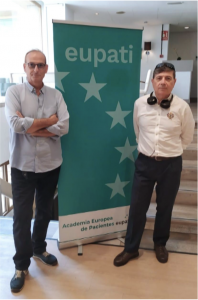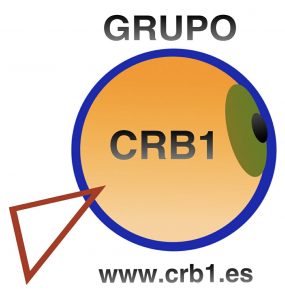
Seville, September 24, 2022
The CRB1 Association of Spain and Latin America has as its main objective to work to give
impulse to the development of a therapy, for the serious diseases of the vision, caused by
the CRB1 gene. For its part, the ENACH Association seeks to cure or chronify the
Neurodegenerative diseases that occur with brain accumulation of iron for
patients of this generation

From left, Antonio López, President of ENACH Association and Miguel Ruiz, President of CRB1 Spain and Latin America
during EUPATI course on Pharmaceutical Industry and Clinical Trials
The CRB1 Association has access to extensive technical knowledge in areas related to genetics, which
It is extremely useful and necessary for the purpose of this agreement. Likewise, ENACH
Association currently has eight translational research projects open, at
while maintaining a network of patients and collaborators both in Spain and in other countries, which
who brings extensive experience in commissioning, project management and attracting
resources, as well as the development of associative movement networks and collaborators.
The pathologies that both entities represent have connection links that have given rise to the
development of this collaboration. Likewise, both parties share a line of vision on the need
of the joint work between Associations of Patients affected by monogenic diseases. The
main objective of this collaboration, which is already underway with work meetings with several
research groups, is the development of a cutting-edge gene therapy that:
⁃
Allow the delivery of larger genes than those already in existence.
⁃
Present very low or non-existent immune response, minimizing the creation of antibodies and the
inflammatory response, which would allow repeat treatment to patients.
⁃
Have a scalable and therefore lower cost compared to existing therapies.
⁃
Allow addressing various monogenic pathologies with the lowest possible levels of adaptations.
⁃
Allow administration in a minimally invasive way, avoiding the risk of procedures
surgical procedures in the operating room, the main obstacle in the administration of gene therapies applied to
diseases of the Central Nervous System.
The representatives of CRB1 and ENACH firmly believe that this collaboration agreement will serve as
updated model, to the paradigm shift that is currently taking place, regarding the new
way of approaching Rare and Prevalent Diseases of monogenic etiologies, giving the
opportunity for Patient Associations to play a more active role in promoting and developing
new therapies, thanks to the great progress of science in recent years and, especially, in Therapies
Genetic and Cellular.
CRB1: https://crb1.es/
ENACH: www.enach.org

